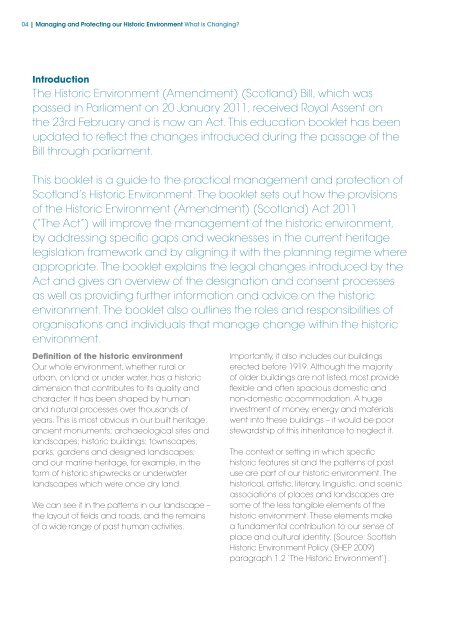Managing and Protecting our Historic ... - Historic Scotland
Managing and Protecting our Historic ... - Historic Scotland
Managing and Protecting our Historic ... - Historic Scotland
Create successful ePaper yourself
Turn your PDF publications into a flip-book with our unique Google optimized e-Paper software.
04 | <strong>Managing</strong> <strong>and</strong> <strong>Protecting</strong> <strong>our</strong> <strong>Historic</strong> Environment What is Changing?<br />
Introduction<br />
The <strong>Historic</strong> Environment (Amendment) (Scotl<strong>and</strong>) Bill, which was<br />
passed in Parliament on 20 January 2011, received Royal Assent on<br />
the 23rd February <strong>and</strong> is now an Act. This education booklet has been<br />
updated to reflect the changes introduced during the passage of the<br />
Bill through parliament.<br />
This booklet is a guide to the practical management <strong>and</strong> protection of<br />
Scotl<strong>and</strong>’s <strong>Historic</strong> Environment. The booklet sets out how the provisions<br />
of the <strong>Historic</strong> Environment (Amendment) (Scotl<strong>and</strong>) Act 2011<br />
(“The Act”) will improve the management of the historic environment,<br />
by addressing specific gaps <strong>and</strong> weaknesses in the current heritage<br />
legislation framework <strong>and</strong> by aligning it with the planning regime where<br />
appropriate. The booklet explains the legal changes introduced by the<br />
Act <strong>and</strong> gives an overview of the designation <strong>and</strong> consent processes<br />
as well as providing further information <strong>and</strong> advice on the historic<br />
environment. The booklet also outlines the roles <strong>and</strong> responsibilities of<br />
organisations <strong>and</strong> individuals that manage change within the historic<br />
environment.<br />
Definition of the historic environment<br />
Our whole environment, whether rural or<br />
urban, on l<strong>and</strong> or under water, has a historic<br />
dimension that contributes to its quality <strong>and</strong><br />
character. It has been shaped by human<br />
<strong>and</strong> natural processes over thous<strong>and</strong>s of<br />
years. This is most obvious in <strong>our</strong> built heritage:<br />
ancient monuments; archaeological sites <strong>and</strong><br />
l<strong>and</strong>scapes; historic buildings; townscapes;<br />
parks; gardens <strong>and</strong> designed l<strong>and</strong>scapes;<br />
<strong>and</strong> <strong>our</strong> marine heritage, for example, in the<br />
form of historic shipwrecks or underwater<br />
l<strong>and</strong>scapes which were once dry l<strong>and</strong>.<br />
We can see it in the patterns in <strong>our</strong> l<strong>and</strong>scape –<br />
the layout of fields <strong>and</strong> roads, <strong>and</strong> the remains<br />
of a wide range of past human activities.<br />
Importantly, it also includes <strong>our</strong> buildings<br />
erected before 1919. Although the majority<br />
of older buildings are not listed, most provide<br />
flexible <strong>and</strong> often spacious domestic <strong>and</strong><br />
non-domestic accommodation. A huge<br />
investment of money, energy <strong>and</strong> materials<br />
went into these buildings – it would be poor<br />
stewardship of this inheritance to neglect it.<br />
The context or setting in which specific<br />
historic features sit <strong>and</strong> the patterns of past<br />
use are part of <strong>our</strong> historic environment. The<br />
historical, artistic, literary, linguistic, <strong>and</strong> scenic<br />
associations of places <strong>and</strong> l<strong>and</strong>scapes are<br />
some of the less tangible elements of the<br />
historic environment. These elements make<br />
a fundamental contribution to <strong>our</strong> sense of<br />
place <strong>and</strong> cultural identity. [S<strong>our</strong>ce: Scottish<br />
<strong>Historic</strong> Environment Policy (SHEP 2009)<br />
paragraph 1.2 ‘The <strong>Historic</strong> Environment’].













![Elgin Cathedral Wedding Brochure [pdf, 544kb] - Historic Scotland](https://img.yumpu.com/22301571/1/190x151/elgin-cathedral-wedding-brochure-pdf-544kb-historic-scotland.jpg?quality=85)



